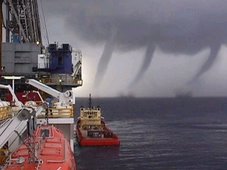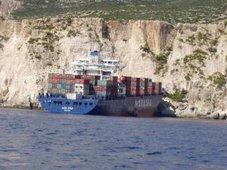 Major Southern California quake drill reveals significant gaps in preparations
Major Southern California quake drill reveals significant gaps in preparationsThe Nov. 13 'shakeout' showed officials that in the event of a 7.8-magnitude temblor they will need more emergency workers, better sources of water and come up with new ways of restoring electricity.
By Jia-Rui Chong December 27, 2008
The largest earthquake drill in U.S. history, held last month in Southern California, found some serious gaps in local earthquake planning, prompting utility companies, emergency managers and others to rethink their planning for a major temblor.The Great Southern California Shakeout was the first time so many agencies and earthquake officials teamed up to examine what would happen if a huge quake struck the region, in this case a 7.8 magnitude temblor. Many Shakeout participants said they have gone through earthquake drills before, but never with a scenario so detailed.
Based on the results of the Nov. 13 experiment, in which each agency estimated damage and emergency services requirements based on detailed quake scenarios developed by supercomputers, officials said they will need more emergency workers, better sources of water and come up with new ways of restoring electricity.Fire protectionFor local fire officials, one of the most worrisome estimates from the drill was the 1,600 fires expected to ignite with lamps overturning, electrical wires shorting and natural gas lines bursting open. Many fires would grow out of control as firefighters struggle to get fire engines across damaged roads and water stopped coming out of their hoses, experts found.
An estimated 200 million square feet of property would be damaged in the blazes. The fires would cause more than 900 deaths -- about half of the total for the earthquake."To hear it quantified like that, it more than got my attention," said Los Angeles County Fire Chief Michael Freeman. "This was really the worst-case scenario for us. Today, if this were to happen, we would need outside assistance."Unfortunately, Freeman said, they probably would not get help for quite some time because neighboring fire agencies would be fighting fires in their own districts and departments from Northern California would have to make their way around damaged highways.
Because they can't afford to multiply their staffs, several fire agencies are looking into training more members of the community to be first responders, learning such skills as basic first aid and turning off gas lines.Freeman said the county is also looking into ways to better draw water from other sources during a disaster, such as pools or storm drains that are collecting runoff from broken pipes.Water suppliesBut the drill also raised troubling questions about how much water would be available after a major quake. Of all utilities, water would take the longest time to restore, experts found. Some communities might have to wait six months for taps to flow again.
The Shakeout helped officials at East Valley Water District in San Bernardino County estimate that they would see about 1,000 leaks in their 450 miles of pipe because about 40% of their pipes are made from a material that is particularly brittle in earthquakes, said Gary Sturdivan, the district's safety and regulatory manager. All 78,000 of its customers would lose water for some period because all of the agency's reservoirs are on one side of the fault and all of its wells and distribution systems are on the other.As a result, the district plans to stock more replacement pipe parts in repair sheds near those areas and store more bottled water for their employees, employees' families that might stay at their facilities and their customers who need water, Sturdivan said.
The water agencies are also retooling their mutual-aid agreements so they can figure out how to prioritize different agencies' needs and distribute replacement parts or water from other states fairly, he said."I think our agency, like a lot of water agencies, was pretty prepared, but it was glaring that we have a long way to go," Sturdivan said. "It was a little overwhelming."Electrical suppliesThe 7.8 temblor modeled by the test would leave large swaths of Los Angeles, San Bernardino and Riverside counties without power, according to estimates by a working group that included utility companies representatives. Breaks in natural gas pipelines could add delays because many plants use gas to generate electricity.
It probably would take about 10 days to restore power to 90% of customers, the estimates found.But Jim Kelly, senior vice president of transmission and distribution for Southern California Edison, said even that is an optimistic forecast."The problem is harder than people initially think," he said. Although Edison already uses equipment designed to be safer in earthquakes, such as transformers with low centers of gravity, Kelly worried about other utilities and parts vendors that would probably be having problems at the same time.
"If we lose bridges or roadways, how are we going to get people or materials to the job site," Kelly asked. "We don't know if rail transit will be available if we don't have roadways."
When Kelly added these potential problems together, he estimated it would take two to four weeks to restore power to the vast majority of Edison's 12 million customers."The scenario's value to us was in identifying that we have to look broader than just our stuff," he said.
Lucile Jones, the U.S. Geological Survey seismologist who served as the chief scientist for the Shakeout, said she hopes the drill gave agencies concrete data that will help them better prepare."People don't need to be convinced an earthquake can happen," she said. "They need concrete statements so they know what to do about it."The effort to develop the scenario cost about $500,000, engaged some 300 experts and took two years to complete.
Geophysicists wanted to plot a plausible event, so they started the earthquake at a part of the San Andreas that has not moved for more than 300 years. They decided the energy stored in that part of the fault could cause a 200-mile rupture moving northwest from Bombay Beach, at the Salton Sea. Quakes of this size are possible, Jones explained, because they rocked San Francisco in 1906 and Fort Tejon in 1857.Seismologists used the supercomputers to calculate the shaking, generating data for 25,000 points of a grid laid out over Southern California.Geologists, engineers, utility managers and other experts used the data to estimate the damage, which included more than 10,000 landslides, more than 50 sewage spills and more than 100,000 addresses losing phone and Internet service for two or more days. Motorists would have to wait one to two weeks to use arterial roads in cities such as Los Angeles and seven months to use damaged highways.
Public health experts estimated some 1,800 people would die and 50,000 would be seriously injured. The economic costs of the disaster, including the business interruption, would total about $213 billion.
The scientists purposefully avoided a worst-case scenario but wanted to analyze an earthquake far more damaging than the 1994 Northridge earthquake, which had a magnitude of 6.7. "We wanted people to understand how bad it could be," Jones said. "Some people think, 'I've been through Northridge,' but getting through Northridge is not enough."
WEATHER NOTE
FEMA uses multimedia to document Ike response
By AMY MOORE
December, 23, 2008
The Federal Emergency Management Agency (FEMA) is allowing access to footage of recovery efforts during Hurricane Ike while staying on the cutting edge of multimedia technology, offering online "webisodes" of the Ike response and recovery missions in Texas.
In step with several other federal agencies, the emergency agency is producing video shorts for its online multimedia site at www.fema.gov/media/multimedia/ to bring the efforts of the agency and recovery information directly to the public.
Using social media tools such as YouTube.com, FEMA is able to capture the various recovery efforts in the areas surrounding the upper Texas Gulf Coast and making it available on some of the most active Internet sites.
The agency has produced 14 videos that highlight urban search and rescue, mitigation efforts, volunteerism, community relations, debris management, private sector outreaching, temporary housing and other human interest stories.
These "webisodes" demonstrate the behind-the-scenes, real-life dramas occurring in the response and recovery efforts after Hurricane Ike.
Other online multimedia resources can be found at:
www.youtube.com/fema - includes vignettes about Hurricane Ike recovery efforts and FEMA programs.
www.twitter.com/femainfocus - lets users get the latest FEMA information and participate in forums addressing issues.
www.fema.gov/radio/index.jsp - features mp3 files of recent radio news and Public Service Announcements.
www.photolibrary.fema.gov/photolibrary/index.jsp - includes FEMA's extensive collection of photos from current and previous disaster operation.
MARTIIME NOTE
Independent investigation into the lifeboat incident on board the
Hong Kong flag bulk carrier Ma Cho at Devonport, Tasmania
9 December 2002
Released
SUMMARY
On 8 December 2002, Ma Cho arrived in Devonport, Tasmania, to discharge a part cargo of fertiliser at number four berth on the western side of the river. On 9 December, the master made the decision to conduct an abandon ship drill before the vessel was due to depart for Geelong. The drill commenced at about 1540 and the starboard lifeboat was prepared for lowering to the water.
At approximately 1548 the mate reported that the crew inside the lifeboat were seated and had fastened their safety belts. Lowering of the boat then commenced with one of the crew operating the davit winch brake from the deck.When the boat had been lowered approximately two metres from the davit head the after on-load release hook suddenly opened, releasing the after fall. The lifeboat’s stern fell to leave the boat suspended vertically by the remaining forward fall with its stern swinging approximately five metres above the water. The boat crew were shaken by the incident but remained secured in their seats inside the now vertical lifeboat. The second mate had sustained a small cut over his left eye.
After the crew had disembarked, the lifeboat was lowered to the water to allow the onload release system to be inspected. It was found that the cable operating the after hook was not properly secured by the saddle clamp under the operating unit. Each time the actuating handle was operated, lost motion was induced by the cable sliding through the clamp and this meant that the after hook was not resetting fully. The cable clamp was temporary repaired and then the lifeboat was housed in its davit. MaCho was subsequently cleared to complete the voyage to Geelong.
The report conclusions include:
• The cable clamp securing the aft hook’s operating cable adjacent to the operating mechanism had been modified which resulted in lost motion within the cable.
• As a result of the lost motion in its operating cable, the after hook had not been fully reset when the previous lifeboat drill was conducted on 2 November 2002.• The design of the on-load release system was flawed with respect to the hook locking mechanism.
• The ship’s safety management system was deficient with respect to both the operating and maintenance instructions and to crew training on the on-load release system.
The report makes a general recommendation to ISM Code accreditation authorities regarding ship safety management systems as they relate to on-load release systems. The report also recommends that the lifeboat manufacturer and classification societies review the design of the on-load release system.
Have a really wonderful weekend!
RS


































































































![Validate my RSS feed [Valid RSS]](valid-rss.png)